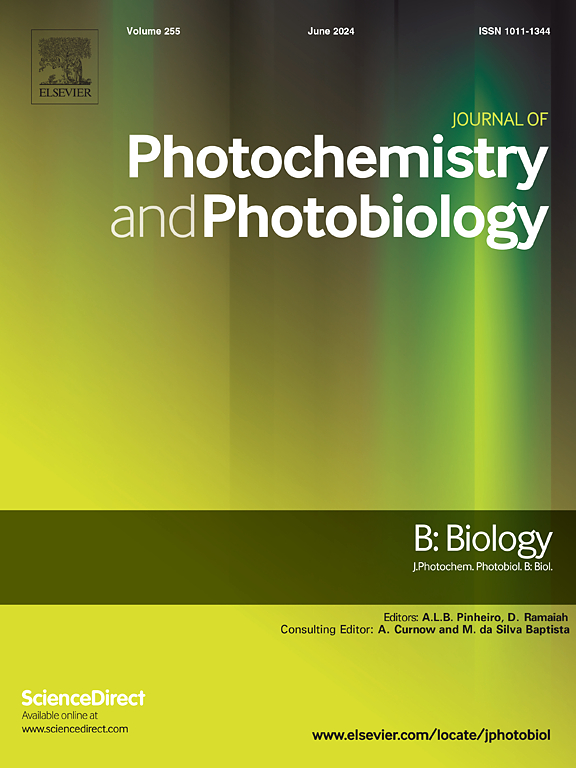Exploring the phototherapy modalities and dosages for an ingestible light-emitting diode capsule to eliminate Helicobacter pylori infection
IF 3.7
2区 生物学
Q2 BIOCHEMISTRY & MOLECULAR BIOLOGY
Journal of photochemistry and photobiology. B, Biology
Pub Date : 2025-03-30
DOI:10.1016/j.jphotobiol.2025.113155
引用次数: 0
Abstract
Helicobacter pylori (H. pylori) infection presents increasing challenges to antibiotic therapies owing to limited drug bioavailability, multi-drug resistance and collateral damage to commensal intestinal microflora. To address these problems, here, an ingestible magnetically controlled light-emitting diode (LED) light source was designed for an ingestible capsule to perform antimicrobial photodynamic therapy (aPDT) without an exogenous photosensitizer (ex-PS) at 630 nm. Specifically, we first optimized the antibacterial rates of aPDT with ex-PS and aPDT without ex-PS against H. pylori at the bacterial suspension level by varying the wavelength (405, 530, 630 nm), photosensitizer concentration (2, 4, 6, 8, 10 μg/mL), power density (15, 30 mW/cm2), and energy density (0, 3.6, 7.2, 10.8, 14.4, 18.0 J/cm2). Then, we compared the antibacterial effect of aPDT with ex-PS and aPDT without ex-PS against H. pylori at the biofilm level, revealing that the antibacterial rate of aPDT without ex-PS reached approximately 97 % at 405 nm and 18 J/cm2, similar to that of aPDT with ex-PS under the same conditions. Furthermore, 80 SD rats infected with H. pylori were treated with aPDT with ex-PS and aPDT without ex-PS at the above wavelengths. Histopathological analysis of rat gastrointestinal tissues revealed that aPDT with ex-PS and aPDT without ex-PS exhibited significant antibacterial activity against H. pylori, without side effects on normal tissues. Additionally, aPDT without ex-PS at 630 nm induced an anti-inflammatory response and regulated the intestinal flora. Ultimately, we developed a magnetically controlled LED capsule for in vivo aPDT without ex-PS at 630 nm against H. pylori.

探索可吸收发光二极管胶囊消除幽门螺杆菌感染的光疗方式和剂量
由于药物生物利用度有限、多重耐药以及对共生肠道菌群的附带损害,幽门螺杆菌感染对抗生素治疗提出了越来越大的挑战。为了解决这些问题,本研究设计了一种可摄取的磁控发光二极管(LED)光源,用于可摄取胶囊在630 nm下进行无外源光敏剂(ex-PS)的抗菌光动力治疗(aPDT)。具体而言,我们首先通过改变波长(405、530、630 nm)、光敏剂浓度(2、4、6、8、10 μg/mL)、功率密度(15、30 mW/cm2)和能量密度(0、3.6、7.2、10.8、14.4、18.0 J/cm2)来优化带前ps和不带前ps的aPDT对细菌悬浮液水平幽门螺杆菌的抑菌率。然后,在生物膜水平比较了aPDT加ex-PS和不加ex-PS对幽门螺杆菌的抑菌效果,发现不加ex-PS的aPDT在405 nm和18 J/cm2下的抑菌率约为97%,与加ex-PS的aPDT在相同条件下的抑菌率相近。此外,80只感染幽门螺杆菌的SD大鼠分别接受上述波长的带前ps和不带前ps的aPDT治疗。对大鼠胃肠道组织的组织病理学分析显示,加前ps和不加前ps的aPDT对幽门螺杆菌具有明显的抗菌活性,对正常组织无副作用。此外,不加ex-PS的aPDT在630 nm诱导抗炎反应并调节肠道菌群。最终,我们开发了一种不含前ps的磁控LED胶囊,用于630 nm抗幽门螺杆菌的体内aPDT。
本文章由计算机程序翻译,如有差异,请以英文原文为准。
求助全文
约1分钟内获得全文
求助全文
来源期刊
CiteScore
12.10
自引率
1.90%
发文量
161
审稿时长
37 days
期刊介绍:
The Journal of Photochemistry and Photobiology B: Biology provides a forum for the publication of papers relating to the various aspects of photobiology, as well as a means for communication in this multidisciplinary field.
The scope includes:
- Bioluminescence
- Chronobiology
- DNA repair
- Environmental photobiology
- Nanotechnology in photobiology
- Photocarcinogenesis
- Photochemistry of biomolecules
- Photodynamic therapy
- Photomedicine
- Photomorphogenesis
- Photomovement
- Photoreception
- Photosensitization
- Photosynthesis
- Phototechnology
- Spectroscopy of biological systems
- UV and visible radiation effects and vision.

 求助内容:
求助内容: 应助结果提醒方式:
应助结果提醒方式:


